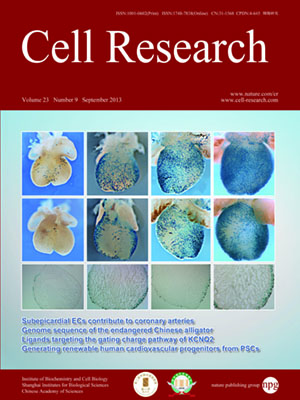
Volume 23, No 9, Sep 2013
ISSN: 1001-0602
EISSN: 1748-7838 2018
impact factor 17.848*
(Clarivate Analytics, 2019)
Volume 23 Issue 9, September 2013: 1106-1118
ORIGINAL ARTICLES
The gating charge pathway of an epilepsy-associated potassium channel accommodates chemical ligands
Ping Li1,*, Zhuxi Chen2,*, Haiyan Xu1, Haifeng Sun2, Hao Li2, Hong Liu2, Huaiyu Yang2, Zhaobing Gao1, Hualiang Jiang2 and Min Li1,3
1CAS Key Laboratory of Receptor Research, Shanghai Institute of Materia Medica, Chinese Academy of Sciences, 555 Zuchongzhi Road, Shanghai 201203, China
2State Key Laboratory of Drug Research, Shanghai Institute of Materia Medica, Chinese Academy of Sciences, 555 Zuchongzhi Road, Shanghai 201203, China
3The Solomon H Snyder Department of Neuroscience, High Throughput Biology Center and Johns Hopkins Ion Channel Center, School of Medicine, Johns Hopkins University, Baltimore, MD 21205, USA
Correspondence: Hualiang Jiang, +86-21-50805873; Fax: +86-21-50807088 E-mail: hljiang@mail.shcnc.ac.cn; Zhaobing Gao, Tel: +86-21-20239067; Fax: +86-21-20239067 E-mail: zbgao@simm.ac.cn; Huaiyu Yang, Tel: +86-21-50800619; Fax: +86-21-50807088(hyyang@simm.ac.cn)
Voltage-gated potassium (Kv) channels derive their voltage sensitivity from movement of gating charges in voltage-sensor domains (VSDs). The gating charges translocate through a physical pathway in the VSD to open or close the channel. Previous studies showed that the gating charge pathways of Shaker and Kv1.2-2.1 chimeric channels are occluded, forming the structural basis for the focused electric field and gating charge transfer center. Here, we show that the gating charge pathway of the voltage-gated KCNQ2 potassium channel, activity reduction of which causes epilepsy, can accommodate various small molecule ligands. Combining mutagenesis, molecular simulation and electrophysiological recording, a binding model for the probe activator, ztz240, in the gating charge pathway was defined. This information was used to establish a docking-based virtual screening assay targeting the defined ligand-binding pocket. Nine activators with five new chemotypes were identified, and in vivo experiments showed that three ligands binding to the gating charge pathway exhibit significant anti-epilepsy activity. Identification of various novel activators by virtual screening targeting the pocket supports the presence of a ligand-binding site in the gating charge pathway. The capability of the gating charge pathway to accommodate small molecule ligands offers new insights into the gating charge pathway of the therapeutically relevant KCNQ2 channel.
10.1038/cr.2013.82
FULL TEXT | PDF
Browse 2553


